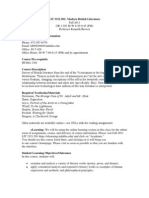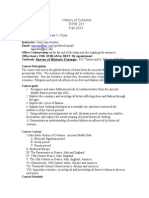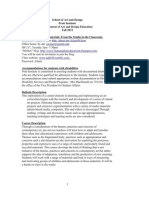Syllabus Ar101 Spring 2012-1
Syllabus Ar101 Spring 2012-1
Uploaded by
lmonsterzCopyright:
Available Formats
Syllabus Ar101 Spring 2012-1
Syllabus Ar101 Spring 2012-1
Uploaded by
lmonsterzCopyright
Available Formats
Share this document
Did you find this document useful?
Is this content inappropriate?
Copyright:
Available Formats
Syllabus Ar101 Spring 2012-1
Syllabus Ar101 Spring 2012-1
Uploaded by
lmonsterzCopyright:
Available Formats
SYLLABUS SPRING 2012 AR101 Introduction to Art Instructor: Lewis Rifkowitz, M.F.A.
Office: FA202c, hours as posted on the door Phone: 735 2716 ---- E-mail: rifkowitz@yahoo.com THE COURSE: A lecture course covering the major art trends and their place in history, art media and technique, criteria for evaluating plastic art and its relationship to other arts. This course is designed as an introduction for students who are interested in learning about art and art history, but do not intend to major in art. This course fulfills the General Education requirement for Aesthetic and Creative Expression. No artistic ability is required. COURSE GOAL: In this course students will be introduced to great artistic monuments of world art with an emphasis on the artifacts which represent the early cultures and civilizations of Western civilization. INTERNET: This semester we will be using an internet program called MOODLE to create dialog with each other about course content and to take quizzes from a revolving bank of questions. This site can be found at http://campus.uogdistance.com/ CLICK on the course name AR101 Introduction to Art F11/L.Rifkowitz Begin by registering for a MOODLE account. To register you will need internet access and an email account. If you do not have either, you must register at the computer center. As a UOG student you are entitled to an account if you paid your student fees. After you have your MOODLE account, click on the course and enter your Art experience. Your special enrollment phrase is life is art Almost every week there will be a dialog question posted in the assignment section posted. Your participation in the dialog addressing each topic is mandatory and essential. You will receive up to 10 points for each topic. There will be ten topics to address for a total of 100 points. COURSE FORMAT, REQUIREMENTS AND ASSESSMENT: This is a hybrid course but predominantly a lecture class. Slides, films and video will be used to illustrate the text and lectures. The student will be expected to come to class. Attendance is mandatory. Come prepared. This means notebook in hand to take notes on lecture materials, reading assignments completed, and ready to ask questions which might arise from the readings. The student can expect eight quizzes which cover the information found in the text and lectures. The student will be expected to identify and analyze slides of artwork in relationship to their style.
LEARNING OUTCOMES: -The student will gain insights into the question of why man creates? -The student will gain an understanding of the different media used to create a work of art and the processes utilized in their creation. -The student will develop a formal and contextual vocabulary to be able to distinguish, identify and analyze the art styles that were produced in the context of culture throughout history. -The student will be able to visually identify works of art based on the style or time frame in which they were created. COURSE TEXT: A History of Western Art 5th Edition, Laurie Addams McGraw Hill Publishers COURSE ASSESSMENT: Attendance: If the student is absent more than three classes over the course of the semester their grade will be lowered by one letter, NO EXCEPTIONS. Class starts at 10:00AM sharp. Exams: These will be found on the Internet and are usually a combination of true/false, multiple choice, fill in the blanks, and short essays about art viewed in class. -The student will also be responsible for slide identification in class. -The eight quizzes will count as 100 points each for a total of 800 points. -The dialog portion of the course will account for a total of 100 points -Attendance counts as 100 points -There will be opportunity for extra credit points Grading: All exams and response papers will be graded on a 100% = 100 points basis. 90% - 100% =A 1000 900 points 80% - 89% =B 899 800 points 70% - 79% =C 799 700 points 60% - 69% =D 699 600 points 59% & below =F 599 Extra Credit : The student will be given two chances to write a response to viewing artwork on island at the Isla Center for the Arts located at House 21 in Deans Circle on campus. The specifics of these assignments will be announced in class. The student will be able to compile up to 20 extra credit points per response paper.
"In accordance with the Americans with Disabilities Act (ADA), UOG will reasonably accommodate individuals with disabilities. You, the student, must self-disclose the need for an accommodation by contacting the ADA Officer at 735-2244/2971. If you disclose your need to me, the instructor, then I must report it to the ADA Officer. Note that documentation is necessary to establish a disability and the need for an accommodation."
The UOG Student Handbook p. 47 says "To not plagiarize." And p. 49. says: "The term "plagiarism" includes, but is not limited to the use by paraphrase or direct quotation, of the published or unpublished work of another person without full and clear acknowledgment. It also includes the unacknowledged use of materials prepared by another person or agency engaged in the selling of term papers or other academic materials." Some faculty members have found that wanting. So from the Univ. of Calgary web-page (www.ucalgary.cal~hexham/study/plag.html), we have: "Plagiarism is the deliberate attempt to deceive the reader through the appropriation and representation as one's own the work and words of others. Academic plagiarism occurs when a writer repeatedly uses more than four words from a printed source without the use of quotation marks and a precise reference to the original source in a work presented as the author's [read plagiarist's] own research and scholarship. Continuous paraphrasing without serious interaction with another person's views, by way or argument or the addition of new material and insights, is a form of plagiarism in academic work."
DISCLAIMER: Certain material shown in this class will show the human body fully exposed. This course material is used to provoke discussion of ideas and not to be used in a prurient manner. If the student has a problem with this please see the instructor. H1N1 Swine Flu
An early flu season is upon us. If you develop flu symptoms (fever with aches and pains, and so on), then you should do the following: 1. Go to the Department of Public Health or your medical doctor to be tested. 2. Stay home; do not come to campus; only visit a doctor. 3. Contact the instructor by email or phone, and make arrangements to do make-up work. 4. Do not spread rumors about H1N1 or other illnesses. Stay healthy, stay fit. Remember that people who smoke are more susceptible to respiratory illnesses such as catching a flu or a cold. For discussion purposes you may want to note that rumors can be more harmful than viruses.
AR101 Introduction to Art Reading list Spring 2012. Here is a general outline of the reading assignments for the semester. This is based on the text A History of Western Art by Laurie Adams 4th edition. If you have another edition please refer to the readings by chapter. Please have your readings completed before the time we are to discuss them. This reading list is tentative and subject to change. 1/18, 1/20 1/23 1/25 1/27, 1/30 2/1 2/3 2/6 2/8 2/10 2/13, 2/15 2/17, 2/20, 2/22, 2/24 2/27 2/29 3/2 3/5, 3/7 3/9 3/12 3/14 3/16 3/19 3/24 3/26 3/28 3/30 4/2 4/4 4/6 4/9 4/11 4/13 4/16 4/18 4/20 4/23 4/25 4/27 4/30 5/2 5/5 5/7 -11 5/14 pp. 1 12 Chapter 1 pp. 13 - 20 Chapter 2 pp. 21 30 Chapter 3 QUIZZ 1, pp. 31 46, Chapter 4 pp. 48 - 65, Chapter 5 pp. 67 80, Chapter 6 pp. 81 93, Chapter 7 pp. 81 114, Chapter 7 pp. 115 122, Chapter 8 QUIZZ 2, pp. 123 134, Chapter 9 pp. 135 149, pp 151 167, Chapter 10 FACULTY DEVELOPEMENT DAY, pp. 169 182, Chapter 11 pp. 183 196, Chapter 12 pp. 198 220, Chapter 13 QUIZZ 3, pp. 222 240, Chapter 14 pp. 241 275, Chapter 15 pp. 241 275, Chapter 15 pp.277 - 305, Chapter 16 pp. 277 305, Chapter 16 pp. 306 315, Chapter 17 QUIZZ 4, pp. 318 330, Chapter 18 pp. 331 364, Chapter 19 pp. 365 381, Chapter 20 pp. 382 393, Chapter 21 SPRING BREAK pp. 394 410, Chapter 22 pp. 411 430, Chapter 23 QUIZZ 5, pp. 431 450, Chapter 24 pp. 451 464, Chapter 25 pp. 466 478, Chapter 26 pp. 466 478, Chapter 26 pp. 478 498, Chapter 27 pp. 498 - 516, Chapter 28 QUIZZ 6, pp. 517 530, Chapter 29 pp. 517 530, Chapter 29 pp. 531 545, Chapter 30 QUIZZ 7 pp. 531 545, Chapter 30 pp. 546 571, Chapter 31 pp. 546 571, Chapter 31 pp. 546 571, Chapter 31 pp. 546 571, Chapter 31 pp. 546 571, Chapter 31 pp. 546 571, Chapter 31 FINAL EXAM(TBA) tentative
You might also like
- ARTH359 SyllabusDocument7 pagesARTH359 SyllabusNicholas Fredrick SchmidtNo ratings yet
- ARTH 2110.002 Syllabus Fall 2020Document5 pagesARTH 2110.002 Syllabus Fall 2020Luis DeVargasNo ratings yet
- L L L I: Critical Terms For Art History Second EditionDocument9 pagesL L L I: Critical Terms For Art History Second EditionAna FrancoNo ratings yet
- Renaissance AssignmentDocument6 pagesRenaissance AssignmentCyryhl GutlayNo ratings yet
- Art Appriciation DR Mariano M ArriolaDocument2 pagesArt Appriciation DR Mariano M ArriolaJebjeb C. BrañaNo ratings yet
- Brailoiu, Constantin - Problems of Ethnomusicology PDFDocument320 pagesBrailoiu, Constantin - Problems of Ethnomusicology PDFDanny Torres0% (1)
- Smith ART 305 Syllabus Fall 2016Document12 pagesSmith ART 305 Syllabus Fall 2016BrandonNo ratings yet
- Arth 205 Syllabus FinalDocument7 pagesArth 205 Syllabus FinalarthurNo ratings yet
- Art 100 Fall 11 SyllabusDocument4 pagesArt 100 Fall 11 SyllabusAndrew RohmanNo ratings yet
- GWC-Art100-Syll-SUMMER2021 Online-1Document4 pagesGWC-Art100-Syll-SUMMER2021 Online-1Emily Gonzalez (Student OVHS)No ratings yet
- Modern Art SyllabusDocument6 pagesModern Art SyllabusA M Z100% (1)
- ART 1301 - Introduction To ArtDocument5 pagesART 1301 - Introduction To ArtdannyNo ratings yet
- Grodger@uwm - Edu: Culture. New York: Oxford University Press, 2014Document5 pagesGrodger@uwm - Edu: Culture. New York: Oxford University Press, 2014Julian AquinoNo ratings yet
- Maria - Buszek@ucdenver - Edu: CAM Vision & MissionDocument18 pagesMaria - Buszek@ucdenver - Edu: CAM Vision & MissionjuguerrNo ratings yet
- Howell 101-025 TR Fall 19Document5 pagesHowell 101-025 TR Fall 19CarolineNo ratings yet
- Spring 2013 195 384 01 Poetry AndersonDocument7 pagesSpring 2013 195 384 01 Poetry AndersonRaul Feria NajeraNo ratings yet
- HUM101Document50 pagesHUM1012B VILORIA, Kristine Joyce D.No ratings yet
- Spanish Civ and Cult - CSUSDocument11 pagesSpanish Civ and Cult - CSUSFranciscoNo ratings yet
- CSUN Art 112 SyllabusDocument7 pagesCSUN Art 112 SyllabusJumiNo ratings yet
- Molloy College Rockville Centre, NY 11571Document7 pagesMolloy College Rockville Centre, NY 11571Mar MainNo ratings yet
- ANTH 101 Course OutlineDocument12 pagesANTH 101 Course OutlineShantrelle PendigrastNo ratings yet
- Douberley Arthi 1002 Syllabus sp17Document7 pagesDouberley Arthi 1002 Syllabus sp17api-294158340No ratings yet
- FA2020 AAI SyllabusDocument7 pagesFA2020 AAI SyllabusCristinaNo ratings yet
- Black HumourDocument6 pagesBlack HumourGirish chaituNo ratings yet
- Fall07 AH191 01 Art Ideas SyllabusDocument5 pagesFall07 AH191 01 Art Ideas SyllabuskelnaNo ratings yet
- Spring Phil 1000-018Document6 pagesSpring Phil 1000-018api-355057529No ratings yet
- Vschwart@usc EduDocument7 pagesVschwart@usc EduOsvaldo VartorelliNo ratings yet
- Art History 1701 SyllabusDocument5 pagesArt History 1701 SyllabusA M ZNo ratings yet
- ENGL 447 - Crosscurrents/English Literature and European Literature 1 SYLLABUSDocument7 pagesENGL 447 - Crosscurrents/English Literature and European Literature 1 SYLLABUScreativelyinspiredNo ratings yet
- Nonwestern ArtDocument9 pagesNonwestern Artapi-163323964No ratings yet
- HIST 102 - Syllabus - Wilder 2023 AutumnDocument4 pagesHIST 102 - Syllabus - Wilder 2023 AutumnElise RamcourtNo ratings yet
- Malas 600d/latam 580 Sem:latina/o Vis CultureDocument8 pagesMalas 600d/latam 580 Sem:latina/o Vis CultureFelipe QuetzalcoatlNo ratings yet
- ARTH376FALL2021FINALDocument11 pagesARTH376FALL2021FINALNicholas Fredrick SchmidtNo ratings yet
- 3p UDPROCO GRADO OCTAVODocument3 pages3p UDPROCO GRADO OCTAVOShenoa LesmesNo ratings yet
- UT Dallas Syllabus For Lit3321.501.11f Taught by Kenneth Brewer (klb092000)Document7 pagesUT Dallas Syllabus For Lit3321.501.11f Taught by Kenneth Brewer (klb092000)UT Dallas Provost's Technology GroupNo ratings yet
- UT Dallas Syllabus For Ahst3318.501.10s Taught by Charissa Terranova (cxt074100)Document6 pagesUT Dallas Syllabus For Ahst3318.501.10s Taught by Charissa Terranova (cxt074100)UT Dallas Provost's Technology GroupNo ratings yet
- Aigner Syllabus Pierce College Art Appreciation Syllabus Asian Module 2Document10 pagesAigner Syllabus Pierce College Art Appreciation Syllabus Asian Module 2Xander XandersNo ratings yet
- Art History 1700-Pre-Historic Through The Middle AgesDocument5 pagesArt History 1700-Pre-Historic Through The Middle AgesA M ZNo ratings yet
- Global Narratives - SyllabusDocument7 pagesGlobal Narratives - SyllabusUsc BlogsNo ratings yet
- E 132: C W R: Nglish Ollege Riting and EsearchDocument7 pagesE 132: C W R: Nglish Ollege Riting and EsearchleahmnortonNo ratings yet
- ART100 Sec5 FA21 DemingDocument7 pagesART100 Sec5 FA21 DemingPeggy FuNo ratings yet
- Non-Western Art HistoryDocument8 pagesNon-Western Art Historypaleoman8No ratings yet
- September 17, 2004 IssueDocument1 pageSeptember 17, 2004 IssueOfficial 6420No ratings yet
- Middle Eastern Humanities Online 16 Wks Fall 2022Document7 pagesMiddle Eastern Humanities Online 16 Wks Fall 2022roucoulet.williamNo ratings yet
- 2023 Syllabus1780 B Fall WinterDocument8 pages2023 Syllabus1780 B Fall WinterShaylin ArameshNo ratings yet
- Engl 1001W Section 001: Introduction To Literature: Poetry, Drama, NarrativeDocument8 pagesEngl 1001W Section 001: Introduction To Literature: Poetry, Drama, Narrativetj ayumbaNo ratings yet
- Women's Art HistoryDocument5 pagesWomen's Art HistoryJenJamesNo ratings yet
- Art IV Syllabus 2014Document3 pagesArt IV Syllabus 2014AlisonHeinNo ratings yet
- History of Costume SyllabusDocument3 pagesHistory of Costume Syllabuspaleoman8No ratings yet
- ENGL 1102 SyllabusDocument8 pagesENGL 1102 Syllabusajc812No ratings yet
- 4913 Med Syllabus 2013Document6 pages4913 Med Syllabus 2013api-206021800No ratings yet
- Syllabus (4330)Document3 pagesSyllabus (4330)foreverbriNo ratings yet
- Aranke World On Fire Spring 2019Document12 pagesAranke World On Fire Spring 2019Nay SJNo ratings yet
- ANCIENT ART: Greek and Roman Art and Archaeology (ARHS 4833)Document11 pagesANCIENT ART: Greek and Roman Art and Archaeology (ARHS 4833)Anushka RaiNo ratings yet
- Undergraduate Art Dissertation ExamplesDocument5 pagesUndergraduate Art Dissertation ExamplesWebsiteThatWritesPapersForYouSiouxFalls100% (1)
- AFAM 201: Introduction To African American Studies: Course DescriptionDocument6 pagesAFAM 201: Introduction To African American Studies: Course DescriptionnothereforitNo ratings yet
- ARTH600 01 F14 GreetDocument7 pagesARTH600 01 F14 GreetData NoNo ratings yet
- Ade 630 Fall 2012Document14 pagesAde 630 Fall 2012api-20975547No ratings yet
- Art 213Document8 pagesArt 213optionsdesignNo ratings yet
- Leng-319: Fiction and Film (Fall 2015) : Course DescriptionDocument8 pagesLeng-319: Fiction and Film (Fall 2015) : Course DescriptioncheungwingnokNo ratings yet
- Self Portraits Through the Ages of Art History: Through the Ages of Art HistoryFrom EverandSelf Portraits Through the Ages of Art History: Through the Ages of Art HistoryNo ratings yet
- INDG-3560Y-A - The Living History of Indigenous Dance and Theatre (2022FW - Peterborough Campus)Document19 pagesINDG-3560Y-A - The Living History of Indigenous Dance and Theatre (2022FW - Peterborough Campus)jshcfdhsgfveugwd8iuNo ratings yet
- Representations of Working in Arts Education: Stories of Learning and TeachingFrom EverandRepresentations of Working in Arts Education: Stories of Learning and TeachingNo ratings yet
- Discussing The UndiscussableDocument9 pagesDiscussing The UndiscussablejosefinazuainNo ratings yet
- Las Activities q2Document3 pagesLas Activities q2Anna Jane AdanNo ratings yet
- The Artist MediaDocument36 pagesThe Artist MediaDavid GuevarraNo ratings yet
- Lesson 5. CivilizationDocument2 pagesLesson 5. CivilizationИванNo ratings yet
- Ck1 Art WorksDocument60 pagesCk1 Art WorksKeyvan ShovirNo ratings yet
- Art Art Has Been Considered The Sole Responsible For The Destruction of Moral Values and Source of Infection in Human Life by Plato and Tolstoi RespectivelyDocument2 pagesArt Art Has Been Considered The Sole Responsible For The Destruction of Moral Values and Source of Infection in Human Life by Plato and Tolstoi RespectivelyAmir SakhawatNo ratings yet
- SymbolMagicInEgyptianArt wilkinsonRichardH PDFDocument234 pagesSymbolMagicInEgyptianArt wilkinsonRichardH PDFJM100% (1)
- APPLEPPTDocument13 pagesAPPLEPPTprettyapplejeanNo ratings yet
- Global Intellectual History PDFDocument12 pagesGlobal Intellectual History PDFGigaNo ratings yet
- Handwerk KunsthandwerkDocument12 pagesHandwerk KunsthandwerkBo ColemanNo ratings yet
- Case StudiesDocument35 pagesCase StudiesSushmita VastradNo ratings yet
- Ploning, Faith Depiction in Film: Jophen Baui Candidate, PHD LITDocument11 pagesPloning, Faith Depiction in Film: Jophen Baui Candidate, PHD LITJosefina BauiNo ratings yet
- Assignment On Professional EthicsDocument18 pagesAssignment On Professional EthicsDathrang PajatNo ratings yet
- Mary Jane Jacob - An Unfashionable Audience - 50-59Document10 pagesMary Jane Jacob - An Unfashionable Audience - 50-59lilaNo ratings yet
- AHCI2021Document65 pagesAHCI2021LupuNo ratings yet
- Visual Arts GlossaryDocument16 pagesVisual Arts GlossaryGregory FitzsimmonsNo ratings yet
- Antinomies of Realism in Postwar ItalianDocument4 pagesAntinomies of Realism in Postwar Italianbernini1598No ratings yet
- Andrea Giunta Feminismo Na Arte MexicanaDocument31 pagesAndrea Giunta Feminismo Na Arte MexicanaCatiuscia DottoNo ratings yet
- Hermes Alegre Paints The Filipina: Pinay BeautyDocument13 pagesHermes Alegre Paints The Filipina: Pinay BeautyDigit-R Computer ShopNo ratings yet
- MAPEH Reviewer 10 1st GRDocument6 pagesMAPEH Reviewer 10 1st GRjjjjjNo ratings yet
- Repubic of Trinidad and Tobago Ministry of Education: Secondary Education Modernization ProgrammeDocument60 pagesRepubic of Trinidad and Tobago Ministry of Education: Secondary Education Modernization ProgrammeShunaya JosephNo ratings yet
- Ge6 Midterm Reviewer GeneralDocument18 pagesGe6 Midterm Reviewer GeneralKarylle AbelidaNo ratings yet
- MAPEH (Arts) G8: Quarter 2Document40 pagesMAPEH (Arts) G8: Quarter 2Iris Rivera-Perez100% (9)
- Pablo Picasso. An Introduction (PDFDrive)Document200 pagesPablo Picasso. An Introduction (PDFDrive)Strahinja Donic100% (3)
- Art Basel in Miami Beach 2018 Day 1Document27 pagesArt Basel in Miami Beach 2018 Day 1The Art Newspaper100% (1)
- Grade 8 Uzbekistan ArtsDocument8 pagesGrade 8 Uzbekistan ArtsMary Dorothy Anne OmalNo ratings yet

























































































